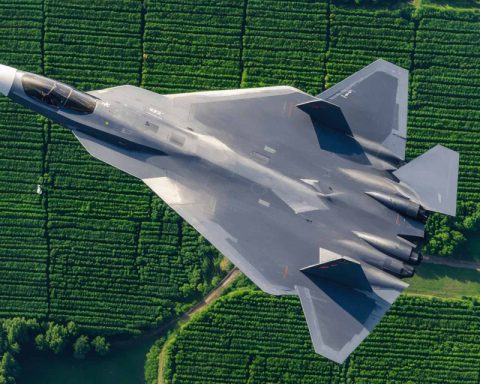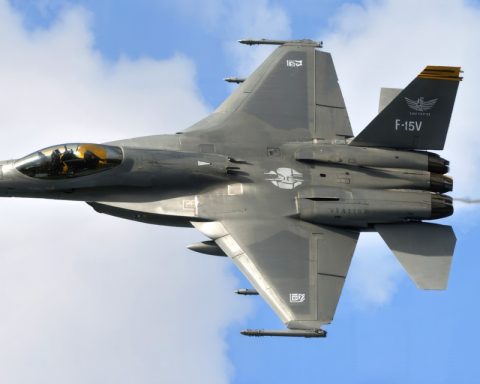In a recent significant development, the U.S. Naval Air Systems Command, on behalf of the United States Department of Defense, has signed a substantial contract with Lockheed Martin amounting to $870 million. This agreement marks the initiation of production efforts for the 20th batch of the versatile F-35 Lightning II fighter jets under the Full-Rate Production phase.
Contract Details and Timeline: This crucial contract secures long-lead materials, parts, and essential components necessary to produce the F-35 aircraft. This particular production batch, known as Lot 20, is destined for various branches of the U.S. military, including the Air Force, Navy, and Marine Corps, alongside international partners and foreign military sales customers. The production work will span multiple locations globally, with a significant portion carried out in Fort Worth, Texas, and completion is anticipated by May 2031.
Funding and Production Background: Funding for this endeavor is drawn from the defense budget for fiscal year 2025, with contributions from U.S. military branches and international partnerships. The ongoing effort follows a key milestone decision allowing for large-scale production, reflecting Lockheed Martin’s maximized production capacity, maintaining an output of around 150 units annually.
Global Impact and Expansion: The F-35 Lightning II continues its global presence with over 1,000 active jets and operations from 33 bases worldwide. Recent developments include orders and agreements from nations such as Romania, Finland, and Greece, demonstrating the growing demand and strategic importance of these next-generation fighter jets. As older aircraft phase out and new threats emerge, the F-35 is poised to ensure air dominance in the coming decades.
The Future of Air Combat: The Role of AI and Technology in the Next Generation of Fighter Jets
In the backdrop of the latest U.S. defense contract with Lockheed Martin for the F-35 Lightning II fighter jets, exciting advancements are unfolding that could revolutionize military aviation and technology. Beyond the substantial investment in the production of the 20th batch of F-35s, recent trends indicate a shift towards integrating cutting-edge technologies that promise to redefine air combat.
AI and Automation in Modern Fighter Jets
While the F-35 Lightning II already showcases advanced avionics and stealth capabilities, the future of fighter jets lies in the embrace of artificial intelligence (AI) and automated systems. The integration of AI can enhance decision-making processes, offering pilots real-time data analysis and threat assessments, increasing response times to rapidly evolving situations. This technological leap aims to maintain air superiority by reducing human error and increasing precision.
Controversies and Concerns
Despite the advantages, the integration of AI in military technology is not without controversy. Concerns about the ethical implications, potential for malfunctions, and escalation of autonomous warfare raise critical questions. How do we ensure accountability in AI-driven combat scenarios? The debate continues as experts advocate for stringent regulations and ethical frameworks to govern the use of AI in defense.
The Role of Quantum Computing
Quantum computing, though nascent, has the potential to revolutionize military strategy. The ability to solve complex calculations instantaneously can transform encryption, radar capabilities, and logistics. Imagine a world where quantum algorithms enhance stealth technology and communication security, rendering traditional systems obsolete. However, with these advantages come the challenges of adapting existing infrastructure and the significant financial implications.
Balancing Act: Advantages vs. Disadvantages
The integration of new technologies in fighter jets offers numerous advantages, including enhanced operational capabilities, increased safety margins, and reduced pilot workloads. However, it also introduces complexities in terms of costs, maintenance, and the need for specialized training. The delicate balance between leveraging new technologies and managing associated risks will shape the future trajectory of military aviation.
Questions and Answers
Can AI completely replace human pilots? While AI can augment pilot capabilities, complete replacement is unlikely in the near future due to the complexity of human intuition and strategic decision-making.
What is the impact of these technological advancements outside military applications? Many innovations pioneered in military aviation trickle down to civilian sectors, boosting advancements in air traffic management, commercial flight safety, and even automotive AI technologies.
Conclusion
The collaboration between defense contractors like Lockheed Martin and emerging technologies marks a pivotal moment in military aviation. As the F-35 program expands, it offers a glimpse into the evolving landscape where AI, quantum computing, and human ingenuity converge, shaping the future of air combat. While challenges and controversies persist, these advancements hold the promise of ushering in a new era of technological proficiency and strategic dominance.
For further insights, explore Lockheed Martin, and stay informed with the latest updates from U.S. Naval Air Systems Command and United States Department of Defense.







